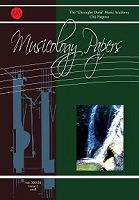Considerations on the dissemination of folklore values in Enescu’s creation
Considerations on the dissemination of folklore values in Enescu’s creation
Author(s): Anamaria CălinSubject(s): Cultural history, Customs / Folklore, Music, 19th Century, Pre-WW I & WW I (1900 -1919)
Published by: MediaMusica
Keywords: Enescu; folklore; models; works; rhythm; techniques; melody; sources;
Summary/Abstract: Embodied in material and artistic productions, the Romanian spiritual culture has given birth to many everlasting masterpieces, of vast stylistic variety and depth. Following the European tendency of using national folklore, the Romanian forerunners (Gavriil Musicescu, George Stephănescu, George Dima, Iacob Mureșianu, Ciprian Porumbescu and so on) had considerable merit in preparing the ground for the great composer George Enescu, in the late 19th - early 20th century. Enescu is the Romanian composer who used and synthesised three important sources: folklore, the music of the Romanian forerunners and the universal tradition. He took the most sensible innovative elements from folklore music, especially the principle of improvisation, the permanent modulation and variations of the material. Enescu’s position towards folklore is visible in the way he used it in his creations, at first affectively, instinctively, and afterwards in a more complex, rational, deliberate way. In the second stage of his creation, George Enescu used the method of creating in Romanian folklore style, initiating a musical trend that went beyond the Romanian framework.
Journal: Lucrări de Muzicologie
- Issue Year: 33/2018
- Issue No: 2
- Page Range: 7-12
- Page Count: 6
- Language: English
- Content File-PDF

